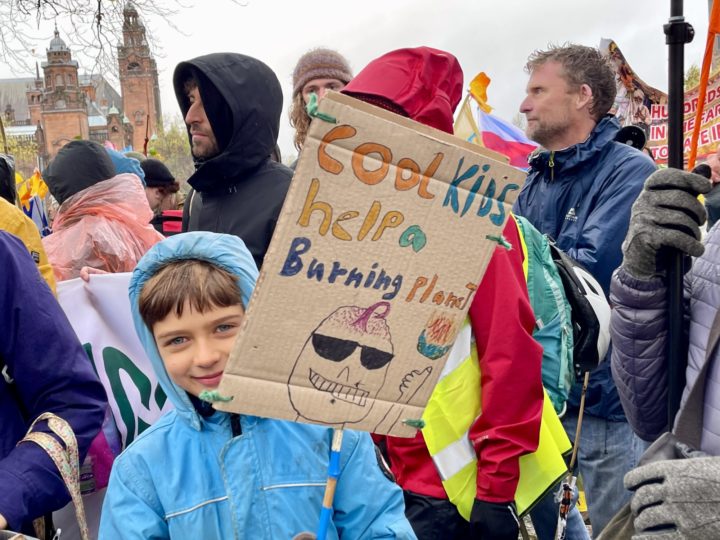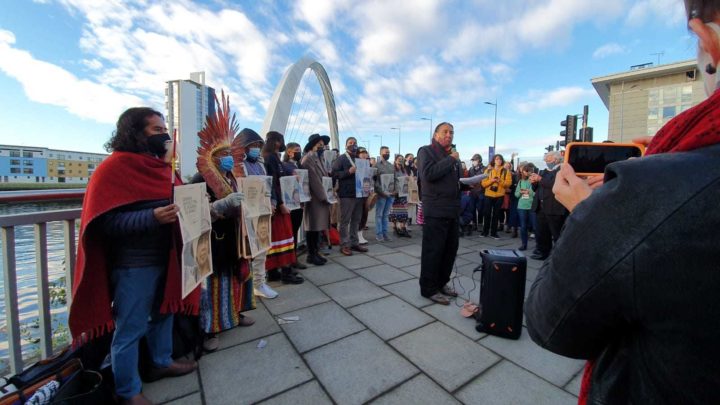COP26: Real progress, real work ahead
Gareth Redmond-King reflects on key announcements at week one, and looks ahead to what to expect for week two.

By Gareth Redmond-King
@gredmond76Share
Last updated:
Progress … but not enough yet
As we head past the half-way mark at COP26, how are we doing? Has it failed, is it blah, blah, blah, and, as the bloke at the gate was yelling on Friday, are we watching for the greenwash?
Before COP, it was clear there would be no one finishing line. A COP that keeps the goals of the Paris Agreement within reach is one that achieves progress across three areas: narrowing gaps (emissions, finance, adaptation, loss and damage); closing Paris rulebook negotiations; and landing sector deals for real-world emission cuts. Additionally, delivering a means of speeding up the process so that pledges are updated more frequently where they’re not aligned with 1.5°C.

Gaps
Week one has delivered some progress on one – maybe two – of those gaps. Most notably, amid the continued refusal of nations like Australia and Brazil to do anything useful, one leader’s speech stood out. India’s Prime Minister Narendra Modi came to Glasgow and pledged the nation to achieve net zero by 2070. Many who reported on that looked disapprovingly at the gap between that and 2050. But on the principle that rich nations lead, it is definitely not unfair compared with the pledges of the EU, US and UK. And if, as seems possible, the commitment is for all greenhouse gases, then this could be genuinely in line with the Paris Agreement and a 1.5° world.
Little else has been offered up yet by way of enhanced emissions pledges. But a few more commitments on climate finance may, believes US climate change envoy John Kerry, leave delivery of the promised $100bn a year by 2020 two years late rather than three. But that is not totally clear yet – and nor is it a huge cause for celebration. Negotiations for moving beyond the $100bn after 2025 seem to be going nowhere quite yet, with fairly entrenched positions along lines between developing and developed countries.
Rulebook
The issue of all nations working to a common timeframe of five or ten years for emission-cutting pledges seems to have moved forward, with options going to Ministers. Complex carbon trading rules – Article 6 of the Paris Agreement – were being described by terms such as ‘not terrible’ by those close to them, with experts believing the issue to be resolved this COP. Let’s see what new complexities emerge this week.
Transparency rules governing how nations account and report on emissions seem to be most difficult with positioning becoming political and fraught. Many seem to think this may be the issue that could keep us in Glasgow beyond Friday evening…
‘Sector deals’
Building ambition beyond NDCs to help plug the gap to 1.5°C – with the aim of creating progress that more stretching future NDCs can capture – was an important part of the UK Presidency’s aim for this COP. This is perhaps where there has been most progress this week with so-called ‘sector deals’ – coalitions of countries and companies committing to collaborate to deliver real-world emission-cutting action. These were:
- A EU/US-initiated pledge on cutting methane by 30% by 2030 – more than 100 countries.
- A plethora of commitments on coal covering, it was claimed, 190 entities; E3G make sense of it here.
- An $8.5bn package of support from the US, UK and European countries to South Africa to enable a just transition away from reliance on coal, creating a template for other coal-dependent states to make the shift.
- 20 nations – including the US and Canada – pledging an end to their combined $18bn in funding for overseas fossil fuels.
- 40 global leaders setting out to deliver on ‘Glasgow Breakthroughs’ to set worldwide standards and policies to give greater certainty to investors into clean energy in five sectors, initially - steel, road transport, agriculture, power and hydrogen.
- More than 100 world leaders pledged to end and reverse deforestation by 2030, mobilising $19.2bn in public and private funds.
- 45 nations committed to work together to protect nature and transform agriculture to cut emissions.
- And lastly, and less substantially, the Glasgow Financial Alliance for Net Zero (GFANZ) laid claim to there being some $130 trillion in private finance ready to fund the clean transition.

There is a lot here – none perfect, complete or necessarily easy to quantify in terms of emissions cuts. But they are significant – some more impactful than others – and crucial for momentum. They have, in this first week, put in place the building blocks for the foundations of a successful outcome at COP26.
But scrutiny has been close and greenwash detectors set to their most sensitive. Under scrutiny, some nations have resiled from what they are supposed to have promised. Poland, for instance, denied that their coal phase out date had come forward from 2049. There is also the issue of double-counting: where a nation has specifically pledged to cut methane emissions, then if it counts that towards achieving its emissions cut in its NDC, the methane pledge itself won’t have made an additional dent in emissions.
These deals will clearly require continued scrutiny to be sure they deliver. But, perhaps with the exception of GFANZ, none of this has exposed fundamental weaknesses with the deals. Rather they have been the victim of over-engineered announcements.
Take coal for instance. The announcement essentially implied 190 countries were quitting coal; as they say on social media, huge if true. But in perfectly reasonable efforts to parse the announcement and understand what was actually being promised, you could be forgiven for thinking that the announcement was unravelling a little.
In fact Ember, who understand this space very well, believe that this announcement is strong enough to move the global dial further towards actual coal phase-out. The announcement could have landed this point if it had simply been clearer that there were a range of commitments, of varying degrees of ambition, with some moving things on further than others; that overall, this is market-shifting and momentum-driving.
Week two
There’s more to come on sector deals. On Wednesday, Denmark and Costa Rica unveil the detail of their Beyond Oil and Gas Alliance (BOGA) – shifting the focus onto exploration and production of oil and gas. There is also a focus that day on speeding the demise of the internal combustion engine.
But there’s more tricky stuff ahead. Already, Saturday’s plenary meeting to bring together all the strands of negotiations to frame the work ahead this week finished late and carried work over to Monday.
So can progress be made to get the rest of the building blocks in place for momentum towards an overall success?

Fairness for developing nations
Most attention this week will turn to neglected areas of the Paris Agreement - adaptation and loss and damage. In week one, developing countries watched very big cash numbers being swept into things like the clean energy transition and tackling deforestation, whilst the $100bn promise remains undelivered, and none of the claimed $130 trillion from still-fossil-fuel-soaked private investors is being deployed anywhere near adaptation in climate vulnerable nations.
So work should progress on the global goal on adaptation – what that could look like and how it will be negotiated and agreed. Climate vulnerable nations and civil society will be looking for recognition of the need for loss and damage finance, genuine technical support and bringing the issue routinely onto the COP agenda. Leading this off in week one, Scotland became the first developed nation to offer finance for loss and damage, putting forward £1m - a tiny amount, but a challenge to western nations that are so far keeping their wallets tightly sealed.
And acceleration, acceleration, acceleration – the watchword left by the leaders when they headed off from Glasgow. How to ensure that parties not in line with 1.5°C will come back with stronger NDCs sooner than planned – maybe, as some are asking, before COP27 in Egypt?
Overall?
Overall, week one has seen real progress on real world climate action collaboration. As well as some flannel and fluff that needs more substance and integrity (looking at you GFANZ).
The work has started on the rulebook, and there’s been some progress on the gaps. It is unlikely that there is widespread belief that enough has been offered yet to keep warming to 1.8° or 1.9°; even if it had, that’s still some way off 1.5°C. So far, the most tangible we can see is a slightly lower rise in emissions in the 2030s, according to the new UN synthesis report.
But we go into week two with decent foundations and potential for momentum; but with a job that will call for all the focus, attention and diplomatic skill of the presidency and the UNFCCC, with high ambition and climate vulnerable nations working closely to lock in troublemakers.
Progress on adaptation and loss and damage is crucial this week if the momentum is to excite developing as well as developed countries. And acceleration this decade will be a really important part of the outcome.
Share